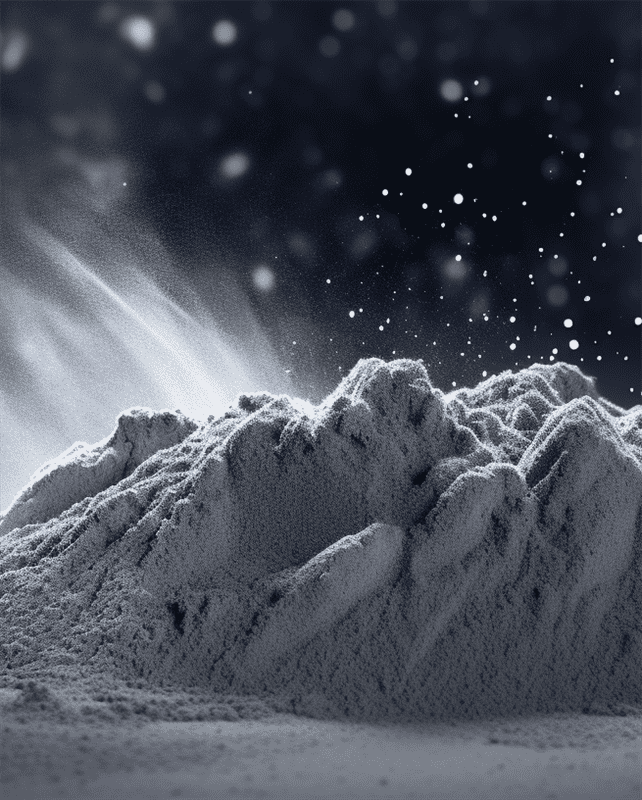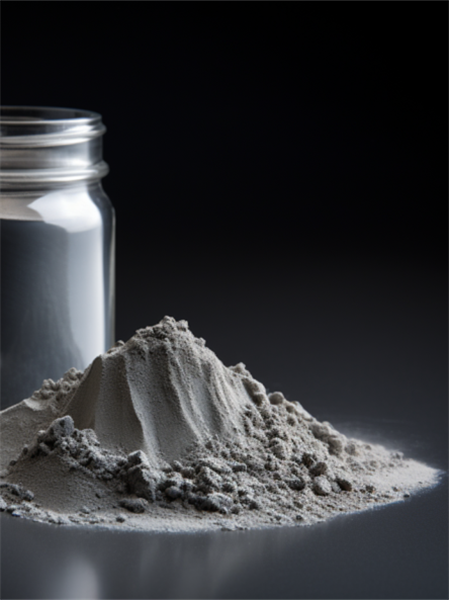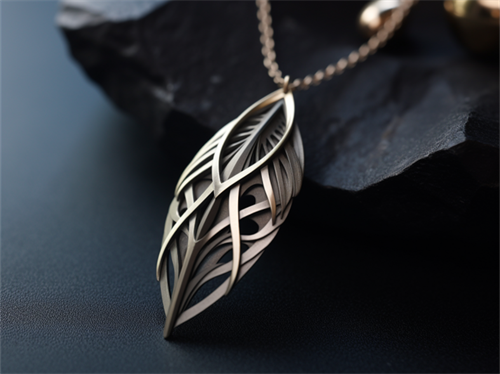Bubuk tungsten adalah bubuk abu-abu halus yang terbuat dari logam tungsten. Serbuk ini memiliki sifat unik yang membuatnya berguna di banyak aplikasi industri dan komersial. Panduan ini memberikan gambaran umum yang komprehensif tentang bubuk tungsten, metode pembuatan, aplikasi, pemasok, biaya, dan banyak lagi.
Tinjauan Umum tentang Bubuk Tungsten
Bubuk tungsten, juga dikenal sebagai bubuk logam tungsten atau bubuk Wolfram, mengacu ke partikel berukuran mikron dari unsur tungsten murni. Tampak sebagai bubuk abu-abu kehitaman yang terasa berat dan berpasir saat disentuh.
Tungsten memiliki titik leleh tertinggi dari semua logam dan sangat padat dan keras. Hal ini memberikan bubuk tungsten sifat suhu tinggi yang sangat baik serta ketahanan aus, kekerasan, dan daya tahan. Pada saat yang sama, ini dapat dipadukan dengan logam lain atau dibentuk menjadi bentuk melalui teknik metalurgi serbuk.
Beberapa sifat dan karakteristik utama bubuk tungsten meliputi:
- Kepadatan tinggi - 19,3 g/cm3, hampir dua kali lipat dari timbal
- Titik leleh tinggi - 3422°C, tertinggi dari semua logam
- Koefisien ekspansi termal yang rendah
- Konduktivitas termal dan listrik yang sangat baik
- Ketahanan terhadap keausan, erosi, dan lengkung
- Biokompatibel dan tidak beracun saat murni
- Warna hitam keabu-abuan dengan kilau metalik
Serbuk tungsten tersedia dalam berbagai ukuran partikel mulai dari 1 mikron hingga 150 mikron. Bentuk partikel bisa bulat, bersisik, atau tidak beraturan. Serbuk yang lebih halus memberikan pencampuran yang lebih seragam dan densifikasi yang lebih baik. Partikel kasar lebih disukai untuk aplikasi seperti anak timbangan tungsten.
Proses manufaktur utama yang digunakan untuk memproduksi serbuk tungsten adalah reduksi hidrogen dari oksida tungsten. Serbuk tungsten murni berwarna abu-abu perak cerah sementara kualitas yang tidak murni tampak berwarna cokelat atau hitam.

Aplikasi dan Penggunaan Bubuk Tungsten
Bubuk tungsten memiliki beragam kegunaan di berbagai sektor utama berikut ini:
Militer dan Pertahanan
- Paduan tungsten pada penembus energi kinetik, amunisi penembus lapis baja, pemberat pada rudal dan roket
- Bola dan anak panah tungsten karbida dalam amunisi antitank
- Perisai radiasi dalam reaktor nuklir
Otomotif
- Filamen tungsten dalam bola lampu dan lampu
- Titik kontak dan komponen listrik yang tahan terhadap lengkung
- Bantalan bola tungsten karbida dan komponen tahan aus lainnya
- Paduan tungsten untuk komponen mesin seperti katup dan turbocharger
- Komponen penyeimbang dan peredam getaran
Manufaktur
- Alat potong, cetakan, dan pelubang yang dibuat dengan tungsten karbida
- Elektroda tungsten untuk pengelasan
- Ditambahkan ke baja untuk membuat baja perkakas berkecepatan tinggi
- Komponen untuk kontak listrik dan pemanasan resistansi
- Perahu penguapan logam dan cawan lebur
Elektronik
- Heat sink dan komponen manajemen termal untuk semikonduktor
- Perahu pengendapan uap dan elemen pemanas
- Tip emisi medan, pemancar elektron, dan katoda
- Kontak, konektor, dan kabel utama
- Pelindung radiasi
Kesehatan
- Kolimator, filter, dan pelindung paduan tungsten yang padat untuk mesin sinar-X dan perawatan radiasi kanker
- Serbuk tungsten yang dicampur dengan polimer untuk membuat komposit padat sebagai pelindung radiasi
- Pemberat pemberat untuk peralatan medis
- Komponen untuk implan medis seperti stent dan sekrup tulang
Aplikasi Lainnya
- Penyeimbang paduan tungsten untuk aplikasi seperti tongkat golf, lunas kapal pesiar, bilah rotor helikopter
- Pemberat untuk peralatan olahraga seperti anak panah, bola bowling, kepala stik golf
- Umpan pancing, umpan selam
- Komponen perhiasan
- Pemberat pada kendaraan olahraga motor
Jenis-jenis Bubuk Tungsten
Serbuk tungsten tersedia dalam berbagai tingkatan yang diklasifikasikan berdasarkan ukuran partikel, bentuk, tingkat kemurnian, kepadatan serbuk, dan aplikasi yang dimaksudkan:
| Jenis | Deskripsi |
|---|---|
| Ultrafine | Ukuran partikel di bawah 1 mikron, luas permukaan tinggi, digunakan dalam proses kimia |
| Submikron | 1-5 mikron, morfologi bulat, kemurnian tinggi, digunakan dalam tungsten karbida yang disemen |
| Baik. | 1-10 mikron, densifikasi tinggi, untuk produk pabrik tungsten |
| Sedang | 10-40 mikron, luas permukaan sedang, penggunaan umum dalam metalurgi serbuk |
| Kasar | 40-150 mikron, luas permukaan rendah, digunakan dalam timbangan |
| Murni | 99.9%-99.99% tungsten, tingkat pengotor rendah, abu-abu perak cerah |
| Komersial | Tungsten 97%-99%, mengandung kotoran kecil, keabu-abuan atau kecoklatan |
| Berbentuk | Serpihan, jarum, dendrit, atau bentuk khusus, aplikasi khusus |
Spesifikasi Bubuk Tungsten
Serbuk tungsten untuk keperluan industri harus memenuhi berbagai spesifikasi fisik, kimia, dan morfologi sesuai standar internasional seperti ISO, ASTM, DIN, JIS, GB, dan GOST:
| Parameter | Spesifikasi Umum |
|---|---|
| Ukuran partikel | 1 - 150 mikron |
| Bentuk bubuk | Bulat, tidak beraturan, bersisik |
| Kepadatan yang tampak | 2 - 3 g/cm3 untuk bubuk yang tidak disinter |
| Kerapatan ketukan | 4 - 6 g/cm3 untuk bubuk yang tidak disinter |
| Kemurnian | 99% hingga 99,995% tungsten |
| Kandungan oksigen | <100 - 1000 ppm |
| Kandungan karbon | <100 - 500 ppm |
| Kotoran logam berat | Batas bagian per juta untuk setiap elemen |
| Luas permukaan | 0,5 - 15 m2 / g untuk bubuk |
| Warna | Abu-abu perak cerah hingga abu-abu kecoklatan |
| Laju aliran bubuk | Pengujian flowmeter aula |
Karakteristik serbuk yang optimal seperti distribusi ukuran partikel, morfologi, kerapatan semu, dan kerapatan tap bergantung pada persyaratan pengepresan dan sinter untuk komponen akhir. Campuran serbuk tungsten khusus diformulasikan untuk memenuhi kebutuhan setiap aplikasi.
Standar Desain dan Rekayasa
Komponen metalurgi serbuk tungsten dirancang sesuai dengan berbagai standar internasional yang mengatur komposisi, manufaktur, pengujian kontrol kualitas, dan aplikasi:
| Standar | Detail |
|---|---|
| ASTM B777 | Spesifikasi standar untuk bahan dasar tungsten, paduan dengan kepadatan tinggi |
| ISO 13320 | Spesifikasi untuk logam keras - Briket serbuk logam |
| MIL-T-21014 | Spesifikasi militer untuk produk pabrik tungsten dan paduan tungsten |
| SAE-AMS-T-21014 | Spesifikasi material kedirgantaraan untuk bentuk pabrik tungsten |
| GB / T 13383-2008 | Standar Cina untuk batang dan batang tungsten |
| JIS C 2805 | Standar industri Jepang untuk produk pabrik tungsten |
| DIN 2240 | Standar Jerman untuk produk pabrik logam berat |
Produsen komponen dan bubuk memastikan kepatuhan terhadap standar yang berlaku untuk kimia, struktur mikro, sifat mekanik, pengujian non-destruktif, jaminan kualitas, dan banyak lagi.
Manufaktur dan Produksi
Serbuk logam tungsten terutama diproduksi oleh reduksi hidrogen dari oksida tungsten:
Serbuk tungsten oksida + Hidrogen → Serbuk tungsten + Uap air
Ini adalah proses eksotermik yang dilakukan pada suhu 700-1000°C dalam atmosfer hidrogen di dalam tungku reduksi khusus.
Langkah-langkah utama dalam produksi serbuk tungsten adalah:
- Penambangan dan ekstraksi - Bijih tungsten seperti wolframite dan scheelite ditambang, dihancurkan, digiling, dan dipekatkan melalui flotasi buih untuk menghasilkan amonium paratungstate (APT).
- Konversi ke oksida - APT diuraikan secara termal menjadi tungsten trioksida (WO3) yang digiling menjadi bubuk kuning/coklat halus.
- Pengurangan hidrogen - Serbuk WO3 mengalami reduksi dengan gas hidrogen kering di dalam pendorong, sabuk, atau tungku putar pada suhu hingga 1000 ° C.
- Penggilingan dan klasifikasi - Serbuk tungsten yang telah direduksi digiling dalam ball mill, diklasifikasikan ke dalam ukuran partikel yang berbeda, dan menjalani pemrosesan lebih lanjut.
- Pencampuran dan pemadatan - Serbuk dicampur, dilumasi, dipadatkan menjadi bentuk awal 'hijau', dan disinter menjadi komponen jadi.
Tingkat kemurnian tinggi dapat mengalami tambahan hidrogen atau degassing vakum untuk menurunkan tingkat pengotor. Serbuk yang dibentuk dan diberi perlakuan permukaan dibuat dengan menggunakan teknik khusus. Morfologi serbuk, distribusi ukuran, kemurnian, dan kimiawi dikontrol secara ketat untuk memenuhi kebutuhan setiap aplikasi.

Pemasok dan Harga
Beberapa pemasok global terkemuka untuk bubuk tungsten meliputi:
| Perusahaan | Lokasi |
|---|---|
| Kerbau Tungsten | AMERIKA SERIKAT |
| Midwest Tungsten | AMERIKA SERIKAT |
| TaeguTec | Korea Selatan |
| Wolfram | Austria |
| HC Starck | Jerman |
| Xiamen Tungsten | Cina |
| JX Nippon Mining | Jepang |
Harga bubuk tungsten tergantung pada faktor-faktor seperti:
- Kemurnian - Berkisar dari US$50/kg untuk tungsten 97% hingga lebih dari $1000/kg untuk serbuk ultrafine 99,995%
- Ukuran partikel - Ultrafine di bawah US$100/kg, bubuk berukuran mikron US$30-60/kg, kelas kasar lebih murah
- Kuantitas - Harga lebih rendah untuk jumlah curah dalam ton
- Sifat bubuk - Bulat dan kepadatan tinggi lebih disukai untuk menekan biaya lebih banyak
- Konsistensi produk - Merek-merek global yang sudah mapan memiliki harga yang lebih tinggi
Kisaran Harga:
- Kelas bawah: $30-$50 per kg
- Kelas menengah: $50-$150 per kg
- Kemurnian/kinerja tinggi: $150-$1000 per kg
Hubungi pemasok terkemuka untuk mendapatkan penawaran harga yang tepat berdasarkan spesifikasi dan volume pembelian Anda.
Bagaimana Memilih Pemasok Bubuk Tungsten
Berikut ini adalah kiat untuk memilih produsen dan pemasok bubuk tungsten yang andal:
- Tinjau kredensial perusahaan termasuk lama berbisnis, reputasi, dan pelanggan
- Pastikan mereka dapat menyesuaikan karakteristik bedak untuk memenuhi kebutuhan Anda
- Carilah kualitas yang konsisten, pengujian yang ketat, dan sertifikasi ISO 9001
- Mengevaluasi kapasitas produksi dan kemampuan mereka untuk meningkatkan pasokan jika diperlukan
- Pertimbangkan lokasi dan logistik untuk pengiriman yang efisien ke fasilitas Anda
- Meminta sampel untuk menguji kualitas bubuk sebelum melakukan pembelian dalam jumlah besar
- Bandingkan harga dari pemasok yang berbeda untuk efektivitas biaya
- Memastikan kemurnian produk yang tinggi, keandalan, dan konsistensi lot-ke-lot
- Periksa waktu tunggu dan ketersediaan inventaris untuk menghindari kehabisan stok
- Mengevaluasi fleksibilitas untuk pesanan uji coba dalam jumlah kecil atau untuk mengakomodasi permintaan yang mendesak
- Pertimbangkan layanan bernilai tambah seperti pencampuran, analisis kimia, dan pengemasan khusus
Panduan Pemasangan dan Pengoperasian
Penyimpanan dan Penanganan
- Simpan bubuk tungsten dalam wadah yang bersih, kering, dan tertutup rapat, jauh dari kelembapan, percikan api, dan api
- Gunakan selimut gas inert jika menyimpan lebih dari 6 bulan
- Batasi paparan udara untuk meminimalkan oksidasi
- Menyediakan sistem ventilasi dan pengumpulan debu yang tepat
- Hindari kontaminasi dari kotoran, minyak, atau serbuk halus lainnya
- Tangani dengan menggunakan sendok dan alat yang bersih; kenakan APD seperti masker, sarung tangan, kacamata
- Mencegah penumpukan serbuk pada permukaan untuk meminimalkan risiko ledakan debu
Pemrosesan dan Pengoperasian
- Lumasi bedak dengan stearat atau lilin sebelum dipadatkan
- Untuk pengepresan, gunakan baja perkakas atau cetakan tungsten karbida yang dilumasi dengan seng stearat
- Padatkan bedak dengan menggunakan sapuan halus dari alat press pada tekanan optimal
- Untuk sintering, gunakan tungku hidrogen atau vakum dan profil pemanasan terkontrol
- Ikuti suhu dan waktu sintering yang direkomendasikan berdasarkan kelas bubuk
- Perlahan-lahan mendinginkan bagian yang disinter di dalam tungku di bawah atmosfer lembam
- Langkah-langkah tambahan seperti infiltrasi, perlakuan panas, atau HIP dapat digunakan sesuai kebutuhan
- Perhatikan tindakan pencegahan keselamatan saat menangani bubuk dan mengoperasikan peralatan
Pemeliharaan
- Periksa wadah bedak dan tempat penyimpanan secara berkala untuk mengetahui adanya kerusakan atau kebocoran
- Segera bersihkan tumpahan serbuk untuk mencegah penumpukan serbuk halus
- Buanglah serbuk dan limbah tungsten bekas dengan aman sebagai limbah industri berbahaya
- Bersihkan cetakan press bubuk, pelubang, dan perkakas lainnya secara teratur
- Lumasi dan rawat mesin cetak sesuai petunjuk produsen
- Ikuti jadwal yang direkomendasikan untuk perawatan dan kalibrasi ulang tungku
Pro dan Kontra Penggunaan Bubuk Tungsten
Keuntungan:
- Sifat suhu tinggi yang sangat baik karena titik leleh yang tinggi
- Ketahanan terhadap keausan dan korosi untuk masa pakai komponen yang lama
- Kepadatan yang sangat tinggi memberikan bobot dan kelembaman
- Biokompatibel dan tidak beracun saat murni
- Konduktivitas termal dan listrik yang baik
- Koefisien ekspansi termal yang rendah
- Dapat dipadukan untuk mengoptimalkan sifat seperti kekerasan
- Metalurgi serbuk memungkinkan fabrikasi komponen bentuk jaring yang kompleks
- Dapat didaur ulang untuk memulihkan tungsten
Kekurangan:
- Mahal dibandingkan dengan serbuk logam lainnya
- Pasokan global yang terbatas dan produksi yang terkonsentrasi di Tiongkok
- Rapuh tanpa modifikasi, membutuhkan paduan atau sintering
- Menantang untuk mesin dalam kondisi disinter sepenuhnya
- Titik leleh yang tinggi membuat fabrikasi menjadi boros energi
- Keuletan dan ketahanan benturan yang lebih rendah dibandingkan baja
- Rentan terhadap oksidasi pada suhu tinggi
- Rentan terhadap kontaminasi selama pemrosesan

PERTANYAAN YANG SERING DIAJUKAN
T: Apa saja jenis serbuk tungsten yang tersedia?
J: Nilai utama diklasifikasikan berdasarkan ukuran partikel (sangat halus, halus, sedang, kasar), kemurnian (99,9% hingga 99,995%), bentuk serbuk (bulat, tidak beraturan, serpihan), dan penggunaan akhir (penggunaan umum, pengepresan, pengelasan, dll.).
T: Berapa ukuran partikel yang terbaik untuk pengepresan dan sintering?
J: Campuran bimodal bubuk yang lebih halus (1-10 mikron) dan lebih kasar (10-40 mikron) adalah optimal, meningkatkan aliran bubuk dan densitas hijau. Serbuk ultrafine juga bisa digunakan.
T: Apa saja efek kotoran dalam bubuk tungsten?
J: Kotoran seperti karbon, oksigen, tembaga, dan besi dapat menurunkan kualitas. Tingkat kemurnian sangat tinggi memiliki pengotor yang lebih rendah untuk aplikasi yang menuntut.
T: Bagaimana bubuk tungsten dipadatkan dan disinter?
J: Serbuk ditekan menjadi padat hijau menggunakan tekanan tinggi dalam cetakan, kemudian disinter pada suhu mendekati 2000 ° C di bawah atmosfer hidrogen atau vakum.
T: Elemen paduan apa yang dapat ditambahkan ke bubuk tungsten?
J: Tungsten dipadukan dengan elemen seperti nikel, besi, kobalt, tembaga, dan renium untuk meningkatkan kekuatan, keuletan, dan sifat lainnya.
T: Apa saja praktik penyimpanan yang direkomendasikan untuk serbuk tungsten?
J: Simpan dalam wadah tertutup di tempat yang bersih dan kering yang terlindung dari kelembapan dan kontaminasi. Batasi paparan udara. Gunakan selimut gas inert untuk penyimpanan jangka panjang lebih dari 6 bulan.
T: Bagaimana bubuk tungsten didaur ulang dan digunakan kembali?
J: Serbuk bekas dan tungsten padat dapat didaur ulang dengan cara dihancurkan, digiling, dicampur, dan dikompresi ulang menjadi produk baru. Tidak terjadi degradasi pada properti.
T: Apa saja aplikasi utama untuk paduan berat tungsten?
J: Komponen militer dan pertahanan seperti penembus energi kinetik, pelindung radiasi, penyeimbang, pemberat, pemberat pemberat, peredam getaran pada aplikasi kedirgantaraan dan otomotif, dll.
T: Apa saja keuntungan menggunakan tungsten dibandingkan dengan uranium yang sudah terkuras?
J: Tungsten non-radioaktif, lebih aman untuk ditangani, tidak terlalu kontroversial, dan lebih mudah didapat daripada uranium yang sudah habis, namun memiliki kepadatan yang sama.
